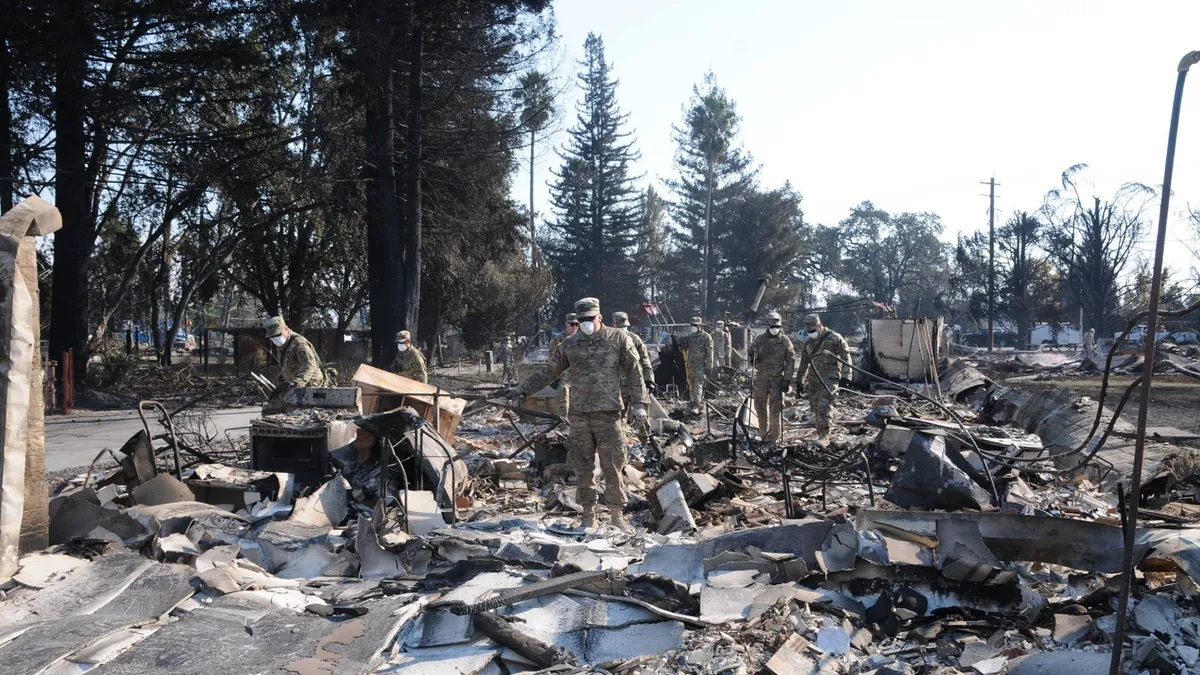UPDATE: November 25, 2020: The California Public Utilities Commission (CPUC) is assessing whether to launch a six-step enhanced oversight and enforcement process on PG&E, due to “what appears to be a pattern of vegetation and asset management deficiencies” on the utility’s behalf, agency President Marybel Batjer said in a letter to PG&E Corp Interim CEO Bill Smith on Tuesday. The six-step process was created as a condition of the company’s exit from bankruptcy earlier this year.
According to Batjer, the CPUC’s Wildfire Safety Division has found “a volume and rate of defects in PG&E’s vegetation management that is notably higher than those observed for the other utilities.” The agency is currently conducting a fact-finding exercise to determine next steps.
Dive Brief:
- The California Public Utilities Commission (CPUC) unanimously voted to approve Pacific Gas & Electric's (PG&E) reorganization plan at a virtual meeting Thursday, bringing the utility one step closer to exiting bankruptcy
- The regulators, however, remained critical of PG&E's track record on safety. Many communities are angry, frustrated and finished with PG&E following the wildfires it caused in Northern California, CPUC President Marybel Batjer said. "At times, I've felt the same," she added.
- The utility is currently in the midst of a multi-day confirmation hearing at the Northern California bankruptcy court, after which U.S. Bankruptcy Judge Dennis Montali, who is presiding over its reorganization case, will decide whether to confirm its plan.
Dive Insight:
Legislation passed by California last year tasked the CPUC with reviewing PG&E's reorganization plan and determining whether it will result in an effective governance structure at the company, align with California's climate goals, and remain neutral to the ratepayers.
The decision approved by the agency Thursday found that the plan complied with these requirements, and included some conditions. It prevents PG&E from passing on the costs of pre-2019 wildfires to ratepayers, and calls for a plan to divide the utility into localized operating regions.
The decision also adopts a six-step oversight process, which would allow the commission under specific circumstances to revoke PG&E's authority to operate. The measures in the decision have been designed to ensure PG&E will exit bankruptcy as a fundamentally changed company, the CPUC said in a press release, adding that it will also reduce ratepayer costs by replacing $12 billion in long-term debt with lower interest rates.
PG&E is a company "whose leadership seems exceptionally unwilling or unable to take responsibility for its failings," Batjer said. The utility's power lines have caused multiple wildfires in Northern California in recent years, killing more than 100 people and driving it into bankruptcy.
But while the commission has created requirements to hold the utility accountable, including requiring changes to its board and restructuring it into localized divisions, "only so much can be imposed on this company externally as regulators. We have put the guideposts in place, but PG&E needs to own its own transformation," she said.
Commissioner Clifford Rechtschaffen said that bankruptcies are messy and complicated, and rarely satisfy all the involved parties. This decision is no different, but "I support it because it provides changes needed to achieve a reformed PG&E," he said, adding that victims of the wildfires will not receive compensation until the bankruptcy is resolved.
Allowing PG&E to exit bankruptcy does not take away from California's broader climate goals, Commissioner Liane Randolph said, noting that PG&E recently proposed procuring 423 MW of battery storage and has expressed a willingness to have conversations around what the state's transition away from natural gas will look like.
"The decision protects the long-standing clean energy contracts that this commission ordered PG&E to execute many years ago, that build the foundation for today's significant energy sector reductions in greenhouse gas emissions," Randolph said.
But many stakeholders were highly critical of the decision. Members of the public called into the meeting for more than two hours to voice concerns about how PG&E's plan will impact its ratepayers and victims of the fires.
"I want to urge you to reject this bad PG&E plan because it really does not compensate the survivors of the wildfires. In addition, I really urge you to focus on prevention of further wildfires, and also the planned power shut-offs," Jessica Tovar told regulators on behalf of the East Bay Clean Power Alliance.
"Why not take the opportunity to hold PG&E to higher standards," Mark Toney, executive director of ratepayer group The Utility Reform Network said in a statement. "No more excuses, no more explanations. Either PG&E stops its criminal conduct or the CPUC moves immediately to revoke its license."
PG&E Corp. President and CEO Bill Johnson said in a press release that the company's main goal is to pay wildfire victims fairly and quickly
"Today's vote keeps us on track to do so. We have supported recommendations from the Governor's Office, CPUC President Batjer and the other Commissioners, and many other stakeholders to hammer out a Plan that will help PG&E become the utility that our customers and communities expect and deserve," said Johnson.
Meanwhile, PG&E Corp. Chief Financial Officer Jason Wells testified at the second day of PG&E's ongoing confirmation hearing at the Northern California bankruptcy court Thursday. Wells was quizzed on the financial feasibility of the plan by William Abrams, a wildfire survivor, who questioned how it would be affected if PG&E were to cause another fire down the road.
"The combination of all the work we're doing to prevent those fires, as well as the passage of AB 1054, create the conditions that would make our plan financially feasible," Wells said.
Wells also said that PG&E's bankruptcy exit plan would not be affected if investigators identify the utility's power lines as having caused the Kincade Fire, which occurred after it filed for bankruptcy. The utility believes damages from the fire would amount to $600 million.
"We have $430 million in insurance available to cover those damages. The net amount would not impact the feasibility of this plan," Wells said.














